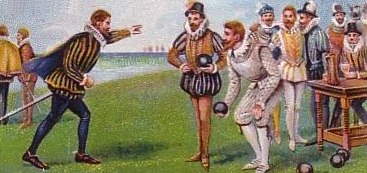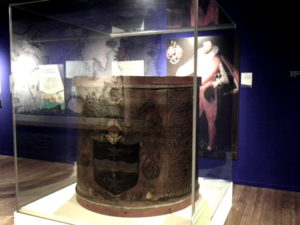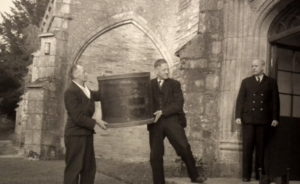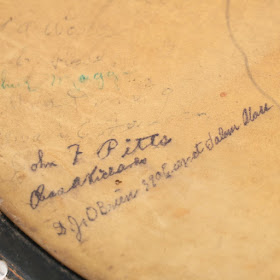For Lee's story about this drum and its maker, see http://blog.bostondrumbuilders.com/2020/05/p-r-winn-drummaker.html.
“Build it and they will drum.” Dedicated to research, study and comparisons of field drums. Our purpose is to collect information about historical U.S. drums (manufacture, preservation, conservancy, repair, market) for use by scholars, collectors and others. Photographs of drums, and anything related, together with informative narratives, are welcome. Interested readers will find archived postings a good resource. Reach us at emirsky@gmail.com.
Thursday, October 29, 2020
P.R. Winn, Drummaker
Monday, September 14, 2020
1826 (?) Brown Drum #1499 Elaborately Painted Sold for $2,600
You can read about the history of Brown drums if you Google Bloomsfield History Museum or Eli Brown Drums.
The drum measures 16" in height x 18" in diameter.
The condition is pretty great considering its age. The wood is in fantastic condition with no cracks, splits, chips or damage. There is one tiny skim chip along the rim (see closeup) but that's it! The leather slides have dried out and the reverse skin has been damaged over the years (also see closeup). As you can see it's really in outstanding condition.
On Jul-30-20 at 10:10:52 PDT, seller added the following information:
Please note: There are other drum enthusiasts who have messaged me that believe this drum may be a replica from the late 1800's with the Brown label added. There are others who believe it's all original from 1826. Some believe it may have been modified when it was painted...who knows for sure? It appears no one can come to a concrete conclusion other than it's a fantastic drum from the 1800's and it could or could not be an authentic Eli Brown. It's being sold "as found" and in the condition stated.
July 21, 2020, from Becky Elliott: I spoke with Ralph Schmoll
who is a patron with the CT historical society and based on his research
he believes this to be an authentic Eli Brown drum. I was hoping
perhaps you would know of someone other than the historical society or
the Fife and Drum Society that would be interested in purchasing it? I
own an estate sale company in Buffalo, NY and this was found in the
treasures of their collections while getting ready for a sale. I was
going to list it on eBay but decided to check with those in the know for
interest before I posted it for sale [https://www.facebook.com/becky.elliott.165/posts/10157664952653022]. Thanks for any interest you
may have.
Becky Elliott
Buffalo Nickel Estate Sales - Buffalo, NY
-----

July 22, 2020, from Ellis Mirsky: Dear Becky, The drum is quite a find. I'd like to speak with you about what I see in the photos and what your plan is with respect to the drum. I'd like to do some of the research concerning the painted emblazonment which could lead us to learning more about the drum's history.
Whether the emblazonment was applied pre- or post assembly could help us date the emblazonment. Close inspection of each tack at the drum shell might reveal the answer.
The tack pattern matches signature Brown tack patterns. Note the greater number (18) of more closely spaced tacks on the leading (left) edge of the overlapping shell than on the trailing (right) portion (13).
The apparently bone grommet is consistent with Brown drums.
Ellis
-----
July 22, 2020, from Ellis Mirsky: Dear Becky, The 30-Star Flag 39-star
The 30-star flag became the official United States flag on July 4th, 1848. It served during 1848-1851. The Brown drum has 30 small stars, 6 stars tucked into each valley between the points of the large star. I think that's consistent with an approximate date ca. 1850 for the emblazonment.
Ellis
-----
July 22, 2020, from Ellis Mirsky: But ... I see 4 more small stars, one in each corner of the emblazonment. A 34-star flag flew from July 4, 1861 to July 3, 1863, squarely within the period of the American Civil War. That's consistent with the drum being made in 1836 (per your description) and painted during the Civil War.
Also, see an article "When is a brown Drum a Brown Drum?," published 12 years ago in my blog FieldDrums.com at https://fielddrums.blogspot.com/2008/07/when-is-brown-drum-brown-drum.html?m=1.
(Note Google lost photos from my blog but ultimately replaced all except those in pre-2010 posts. That post was pre-2010, so no photos.)
Ellis
-----
July 22, 2020, from Ellis Mirsky: Dear Becky,
Two more observations:
1. The snare mechanism is likely "after-market," added after the drum was made.
Please send close-up photos of the snare mechanism and the other (butt) end.
2. The top counter hoop is on backwards. The metal ring affixed to the hoop (called a military carry) should be on the other side (I.e., the hoop should be rotated 180 degrees) so that when the drum is hooked up and carried, the emblazonment shows outwardly from the front.
Ellis
-----
Lively discussion on Facebook about the drum in Fife and Drum Corps Friend’s Group, started by John O'Neill has drawn 57 comments:
See https://www.facebook.com/groups/131326693664150/permalink/1939011106229024.
Can we get clear closeup where indicated?
Ellis
-----
July 28, 2020, from Becky Elliott: The drum is 1826 not 1836...I was able to get a better photo once it was in my hands. It was listed on eBay this evening at the owner's request. Thank you for helping me with identification...much appreciated!
Becky
-----
July 30, 2020, from Becky Elliott: [Re whether the drum was cut down.] I can't say as I'm not sure what it would look like originally. I included measurements so perhaps that will tell?
Becky
-----
Saturday, August 29, 2020
Frederick Lane Drum, pre-Civil War (ca. 1821-1837)
This gem surfaced recently. I guess the date of the drum to be from 1813 (the date of another Frederick Lane drum discussed below) or 1821-1837 based on this mention of the Frederick Lane music store in Boston, Massachusetts
(https://archive.org/stream/onehundredfiftyy00fish/onehundredfiftyy00fish_djvu.txt)/
"One hundred and fifty years of music publishing in the United States; an historical sketch with special reference to the pioneer publisher, Oliver Ditson company, inc., 1783-1933"

Label reads:
FOR SALE AT FREDERICK LANE's
Musical Magazine,
No. 92 COURT STREET - BOSTON,
FOLLOWING MUSICAL INSTRUMENTS,
Bass Drums; Tenor Drums, Bass Viols; Vio-
lins; Clarionets; Flutes; Hauthoys Fife[s]; Bassoons; Bu-
[missing;] Trumpets; French [illegible], &c, [illegible] &c [illegible] ...
gs, reeds - and Instruction Books. [missing]
[missing], which we will sell on [missing]
Music stores on Court St in Boston MA 1855
Photo Posted by George Lane at
https://www.flickr.com/photos/ssave/14447791750/
"Frederick Lane's Music Store was at 92 Court St. (opposite of the Old Court House) from 1820-44. He had bought out N. H. Henchman's Music Shop at 79 State St. in April 1813. He manufactured bass drums for the militia, wind instruments and violins. By the 1830, he also made umbrellas at his shop on Court St.
Source: 1855 Court St Boston BPL 08 02 003376-1 detail2Public Domain
Author unknown - Boston Public Library, Print Department"
-----
Other Frederick Lane drums:
Lot 637: PAINTED MILITIA BASS DRUM, FREDERICK LANE, BOSTON, MASSACHUSETTS, CIRCA 1813-19.

Painted with a view of Massassoit beneath a raised arm brandishing a sword, encircled by a red banner inscribed with the state motto "ENSE PETIT PLACIDEN SUB LIBERTATE QUIETEM (With the Sword We Seek Peace, But Only Under Liberty), within berried laurel branches, the shell painted with red and dark-blue stripes edged in mustard, with the original skins, ropes, hoops and iron strap hook mounted on an iron plate, the interior bearing a partial paper label inscribed "Frederick Lane Keeps Constantly For Sale at His Music Store at No. 79 State Street, Boston, Bassoons with Trumpets, Bird Organs, Tenor Violins...." Height 22 1/2 inches, diameter 24 inches.
Bourgeault-Horan AntiquariansOctober 12, 2006
Portsmouth, NH, US
https://www.invaluable.com/auction-lot/painted-militia-bass-drum-frederick-lane-boston-m-637-c-o38i86v39l
----- Bass drum and mallet 1813–19
Bass drum and mallet 1813–19
Frederick Lane, American, 1791–1865
Boston, Massachusetts, United States
Height 60 cm, diameter 62 cm (Height 23 5/8 in., diameter 24 7/16 in.), Ash
Classification: Musical instruments
On view in the: Musical Instruments Gallery
Ash
(?) shell with painted decoration consisting of an American eagle with
"E Pluribus Unum" on a fluttering banner over a shield. Skin heads held
on by red-painted wood hoops laced with rope and leather tensioners.
Includes old wooden mallet.
Museum of Fine Arts, Boston
Gift
of the Family of Charles E. Black and Gale L. Perron, including Karen
A. Black, Diane L. (Black) Conners, Emmie Perron Black and Katrina
Perron-Black, 1986
Accession number: 1986.937a-b
Provenance/Ownership
History: Donated by Charles E. Black of Hingham, Massachusetts. Black
apparently inherited the instrument from his father, Clarence Edgar
Black, originally from Waldoboro, Maine. It was supposedly handed down
through several generations of the family, and is believed to have been
used in the War of 1812 by Joseph Jewett (1780-1852) of Alna, Maine.
This object is included in the following Selected Tour(s):
•Percussion Musical Instruments
https://fielddrums.blogspot.com/2010/04/
-----
Advertisement for Frederick Lane
https://commons.wikimedia.org/wiki/File:1832_Frederick_Lane_BostonDirectory.png
Boston Directory. 1832. https://books.google.com/books?id=raQtAAAAYAAJ
-----
Also:
Massachusetts Collection of Martial Musick;: Containing a Plain, Easy, and Concise Introduction to the Grounds of Martial Musick, Laid Down in the Most Comprehensive Manner. : Together with a Large Collection of the Most Approved Beats, Marches, Airs, &c.; Including the Principal Part of the Duties of the Camp, the Evolutions for the Musicians, and Their Signals; a Great Part of which was Never Before Published. Designed Principally for the Benefit of the Militia of the United States

Wednesday, June 17, 2020
For BSGK Fans - Rare Slingerland Tiger Skin Drum Kit
1968 Yellow Tiger Pearl jazz set (this finish only available for about one year)
(http://www.coopersvintagedrums.com/newslinghistory.htm)
Historical Drums in the Collection of Mark Goldberg
Sunday, April 12, 2020
Saturday, April 11, 2020
The Drumslingers: LES PARKS UN-TRADITIONAL SNARE GRIP
Read it at http://thedrumslingers.blogspot.com/2009/09/left-hand-pinky-finger-out-snare-drum.html.
And watch the linked video at https://youtu.be/c_SkLdNM5VI.
Sunday, March 15, 2020
Harrison Tyler ("Tip") Prentiss - Civil War Drummer Boy
Biography of Harrison Tyler “Tip” Prentiss
https://www.ancestry.com/mediaui-viewer/tree/39903005/person/19425250118/media/a8e57691-0876-4112-9271-f9d1cfc24cc2
The Prentiss family moved from Missouri to Quincy, Illinois about the time of his birth, most indicating that it was in 1840 when his father Benjamin and mother Margaret and the Prentiss clan, including his grandfather Henry Leonidas and grandmother Rebecca also made the short trip over the Mississippi River east to a free state. Little is known of Tip’s childhood.
By the time of the census of 1860, Tip was listed as an apprentice steamboat pilot, a profession he followed later in life. A more famous contemporary steamboat pilot was Mark Twain, also of Marion County, Missouri, where the Prentiss family had first settled. However, Samuel Clemons was leaving the profession about the time that Tip was beginning.
With the outbreak of war in 1861, Tip followed his father and enlisted in the Tenth Illinois Infantry Regiment. After his ninety day term was up, he returned home and later enlisted as a drummer in the Fiftieth Illinois Regiment. After his ninety day term was up, he returned home and later enlisted as a drummer in the Fiftieth Illinois Regiment. Tip transferred from the Fiftieth Illinois to the Eighty-fourth Illinois where he also served as a musician. Tip participated in the battles of Ft. Henry, Ft. Donelson, Ft. Pillow, Shiloh, Lookout Mountain and Missionary Ridge.
Tip transferred from the Fiftieth Illinois to the Eighty-fourth Illinois where he also served as a musician. Tip participated in the battles of Ft. Henry, Ft. Donelson, Ft. Pillow, Shiloh, Lookout Mountain and Missionary Ridge.
At the Battle of Shiloh Tip, ran to the rear, as did so many men during the first day of battle. While Tip was running away from the battlefield front, his father was busy trying to hold the line at the Hornet’s Nest against the Confederate onslaught. It was said that as Tip ran for the rear he met up with an aide to his father. According to the story Tip asked, “Where is the old man?” The aide replied that, “He’s out there where you hear all that fighting.” Tip responded saying, “Well, if he is out there one member of the family in the fight is enough, I’m going to the river.” When Tip ran for the safety of the bank of the river, he had plenty of company.
Tip was well liked throughout his life. It was claimed that he was “the best drummer in the Union army” and that he was always mirthful and a jokester.[1] Not all of the children of Ben Prentiss followed him back to Missouri from Quincy, although most did. Sons Tip and Guy were adults and remained in Quincy, although Tip would eventually follow his father to Bethany. Tip had a married daughter who remained in Quincy.
Harrison Tyler Prentiss was a well known river man in Quincy and was a likeable and popular figure in the community. In 1882 Tip and two other men were heroes, when they rescued a drowning woman who had jumped off the bridge into the Mississippi. They prevented her from committing suicide. Tip and his two friends were in a boat and close enough to the woman, so that they were able to row their boat to the spot where she had jumped into the water. They were able to successfully fish her out of the water. Not long afterwards Tip suffered a stroke that was accompanied by paralysis to his right side.
By 1887 Tip Prentiss had gone to live at the newly established Illinois Soldiers and Sailor’s Home in Quincy. From there he left to rejoin the Prentiss family in Bethany where he died on April 21, 1897 at the home of his brother Jacob.[2] Tip preceded his father in death, when Benjamin died February 8, 1901.
[1] History of Northwest Missouri, vol. 3, 1308.
The story of Tip fleeing the battlefield coincides with the disarray of his unit, the Fiftieth Illinois Regiment, on the first day of the battle.
[2] Herald, May 30, 1882.
Whig, April 24, 1897.

Saturday, March 7, 2020
The Legend of Drake’s Drum
The Legend of Drake’s Drum
by Ellen Castelow
https://www.historic-uk.com/CultureUK/Legend-Of-Drakes-Drum/?fbclid=IwAR1KeiOFhNE4hHEAsHcOaSZgRkQrwyt2Mxji9rARdWttE2DLD3t-CX0KqUI
And strike it when your powder’s running low;
If the Dons sight Devon, I’ll quit the port of
heaven, and drum them up the channel as we
drummed them long ago.”

Sea captain, explorer, slave trader, privateer and pirate: Drake was all of these and more. To the Spanish he was a pirate (El Draque) but to the English, he was a hero. From the singeing of the King of Spain’s beard – his raid on Cadiz in 1587 – to his voyages around the world ( the first Englishman to do so) Drake was immensely popular.
After his death a legend arose involving a drum, emblazoned with his coat of arms, that had reputedly accompanied him on all his voyages. This was an early European side drum, used on board ship for calls to arms or for entertainment; Drake was fond of music and on his circumnavigation, he took four viol players with him on the voyage. Whilst the drum dates from the 16th century, the coat of arms that decorates it was added in the 17th century.
It is generally believed that Drake’s drum was among the 13 drums rescued from Hawkins’ and Drake’s fatal last voyage to the Caribbean in 1596. Shortly before his death off the coast of Panama in 1596, it is said that he ordered the drum to be taken to Buckland Abbey, his home in Devon. He is said to have vowed on his deathbed that if England were ever in danger and the drum was sounded, he would return to defend his homeland.

– when the Mayflower left Plymouth for the New World in 1620
– when Napoleon Bonaparte entered Plymouth harbour as a prisoner aboard the Bellerophon
– in 1914 on the outbreak of World War One
– in 1918 on HMS Royal Oak just before the surrender of the German fleet
– during the evacuation of Dunkirk in 1940.
Two British army officers also claimed they heard the drum beating during the Battle of Britain in September 1940. It was also said to have been heard beating quietly in 1982 during the Falklands War and on 7th July 2005 when London was hit by a terrorist attack.
The legend of Drake’s drum fits into the category of ‘king of the mountain’ or ‘sleeping hero’ folklore. These are tales of national heroes ready to awake at times of national need, such as the legend of King Arthur and his knights, sleeping in Avalon waiting to arise when required.
Drake’s role as a protector of England is first mooted in a poem written by Charles Fitz Geffrey only a few months after Drake’s death, ‘Sir Francis Drake, His Honourable Life’s Commendation And His Tragical Death Lamentation’. The last few lines of the poem seem to suggest that he is forever watchful over England:
“The sea no more, heaven then shall be his tomb
Where he a new made star eternally
Shall shine transparent to spectator’s eye
But shall to us a radiant light remain
He who alive to them a dragon was
Shall be a dragon unto them again
For with his death his terror shall not pass
But still amid the air he shall remain
This role continued because England wished it to be so! “
The legend was further reinforced in 1897 with the publication of Sir Henry John Newbolt’s famous poem, ‘Drake’s Drum’, some lines from which are quoted at the head of this article.

Sunday, January 26, 2020
A Study of African-American Drum and Bugle Corps and Their Communities
Thesis submitted in partial fulfillment of the requirements for the degree of Master of Music in Music with a concentration in Musicology in the Graduate College of the University of Illinois at Urbana-Champaign, 2017, Urbana, Illinois
(Download Thesis here.)
This thesis examines three Black drum and bugle corps from the Civil Rights era of the nineteen-fifties and sixties: the Carter Cadets and the CMCC Warriors Drum and Bugle Corps from New York City, NY and the Washington VIPs from Washington, D.C.
It uses historical and ethnographic methods to present a history of Black corps, mainly based on interviews with alumni. By using theories of space and community, the goal is to analyze how urban planning made way for the formation of Black corps in inner cities.
These marching ensembles served two purposes within their communities: to teach youth valuable life skills to benefit their socioeconomic advancement, and to protect them from likely life-threatening situations, including drugs and violence, by showing them how to embrace their Black identities and create awareness of different opportunities.
The significance of this study is to present a little- researched performing ensemble within the United States, and base it historically during the Civil rights era to show one way Black communities coped with urban planning and the lack of socioeconomic opportunities in their neighborhoods.
Carter Cadets: https://youtu.be/dHFjBoCaAVs
CMCC Warriors: https://youtu.be/D_G_37ELM7M
Washington VIPs: https://youtu.be/_c47Vi1W6AM
A History of Rudimental Drumming in America
Rudimental drumming gained significance in America during the period of the Revolution. Ever since the late eighteenth century and through the nineteenth century, it was used exclusively in the military. This study traces the migration of drum rudiments and their use in military settings from Great Britain to America.
The contributions of the Swiss drummers and the incorporation of their drum music into American rudimental drumming are also examined.
The introductory chapter covers related pertinent and prefatory topics such as a definition of rudimental drumming, the duties of the military drummer, non-rudimental types of drumming and a summary of the origin and development of rudimental drumming in Europe.
The second chapter, which constitutes the body of the work, begins with an investigation of military drumming in America beginning in the Revolutionary War era and continuing through the nineteenth century. This chapter also includes calls, signals, and various rudiments used by the American military drummer as well as an analysis and inter pretation of the changes that took place in performance practices and notation.
The third chapter deals with rudimental drumming in the twentieth century beginning with the bands of John Philip Sousa, comparing techniques and principles of the past to modern marching percussion sections. Changes in rudiments during this century through the efforts of the National Association of Rudimental Drummers and the Percussive Arts Society are also examined.
The study concludes that many of the same rudiments and patterns used in Europe from the fifteenth century, and in America from the late eighteenth-century, are still used today and have remained unchanged. It has also been concluded that, in comparison to other countries, a large number of drum manuals have been published in America prior to the twentieth century.
A further conclusion acknowledges multiple applications of drum rudiments to other percussion instruments. Often, the work of any such project is measured in part by its usefulness and contribution.
This study will serve as a reference for the rudimental drummer as well as for the historian and could be used by scholars and instructors at all levels.
Download the work at https://pdfs.semanticscholar.org/0330/ec7999200db3b77c0e119ea6efeee71beb32.pdf
or https://www.dropbox.com/s/g9bn6fnwtmtlx2j/Chandler%20Thesis.pdf?dl=0.




















































